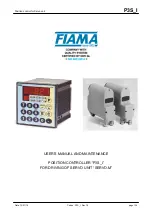
Position control for Servo unit
P3S_I
Data: 13/01/16
Codice: P3S_I Rev 1.0
page 2/14
Manual purpose
This manual has been designed by the Manufacturer to provide the necessary information regarding the
instrument to those who are authorized to carry out safely its installation, maintenance, dismantling and
disposal. All the necessary information for the buyers and planners can be found in the Sales catalogue.
Other than adopting good technical construction methods, the information should be read carefully and
strictly applied. Inobservance of this information could cause risks for the health and safety of people and
economical damage. This information, provided by the Manufacturer in the original language(Italian) is also
available in other languages to satisfy legislative and/or commercial needs.
This manual must be kept in a good condition by a responsible person in an ideal place so that it is always
available for consultation. In case this manual is lost or deteriorates, a replacement should be requested
directly from the manufacturer quoting the manual’s code. This manual reflects the state of skill of the
instrument at the time of input on the market: however the manufacturer reserves the right to make changes,
add or improve the manual without giving any reason to hold the present manual inadequate.
Identification of the equipment
The identification plate represented is applied to the instrument.
To find the identification code of the instrument, consult the sales catalogue.
Environmental conditions
Temperature setting: min. 0°C, max. + 50°C.
It is forbidden to use the instrument other than its specific use and in potentially explosive conditions or where
anti- explosive elements are used.
Storage
Here below are some references to be followed for the storage of the instrument.
Avoid environments with excessive humidity and those exposed to bad weather (avoid open areas). Avoid
putting the instrument directly on the ground. Store the instrument in its original packing.
Conformity declaration and CEE marking
The instrument answers to the following Communitarian Directives:
2004/108/CEE Electromagnetic compatibility, with reference to general Rules EN61000-6-2 (immunity in
industrial environment) and EN50081-1 (emission in residential environment),
2006/95/CEE Low tension, modified Directive 93/68/CE.
Maintenance
Turn off the power before touching the internal parts.
Clean the external plastic parts using a soft, damp cloth with ethylic alcohol or water. Do not use hydrocarbon
solvents (petrol, diluents, etc.): using these products could affect the proper mechanical functioning of the
instrument.
Reparations should be done only and exclusively at the FIAMA technical assistance centre.
Calibrations and tests
It is advisable to calibrate the instrument periodically, once every working year.
To do the calibration, follow the calibration procedure indicated in the present manual.
Assistance request procedure
For any kind of technical assistance request, contact the sales department of the Manufacturer directly
indicating the information given on the identification plate, the number of hours used and the type of defect.
Manufacturer’s responsibility
The manufacturer declines any responsibility in case of:
• Using the instrument contrary to the national safety and accident-prevention laws.
• Wrong installation, inobservance or wrong procedures of the instructions provided in the present manual.
• Defective electrical power supply.
• Modifications or tampering.
• Operations carried out by untrained or unqualified staff.
The safety of the instrument also depends on the strict observance of the procedures indicated in the
manual: always operate the instrument in its functioning capacity and carry out a careful routine maintenance.
• All phases of inspection and maintenance should be done by qualified staff.
• The configurations provided in the manual are the only ones permitted.
• Do not try to use them anyway contrary to the indications provided.
• The instructions in this manual do not substitute but accomplish the obligations of the current legislation
regarding the safety laws.














